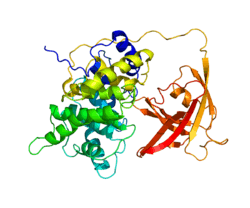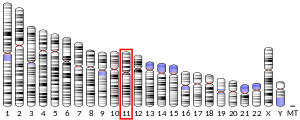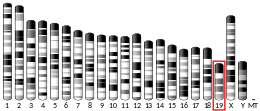Intrinsic factor
Intrinsic factor (IF), also known as gastric intrinsic factor (GIF), is a glycoprotein produced by the parietal cells of the stomach. It is necessary for the absorption of vitamin B12 later on in the ileum of the small intestine.[5] In humans, the gastric intrinsic factor protein is encoded by the GIF gene.[6]:989
| CBLIF | |||||||||||||||||||||||||
|---|---|---|---|---|---|---|---|---|---|---|---|---|---|---|---|---|---|---|---|---|---|---|---|---|---|
 | |||||||||||||||||||||||||
| |||||||||||||||||||||||||
| Identifiers | |||||||||||||||||||||||||
| Aliases | CBLIF, IF, IFMH, INF, TCN3, gastric intrinsic factor, intrinsic factor, Intrinsic factor , IF, cobalamin binding intrinsic factor, GIF | ||||||||||||||||||||||||
| External IDs | OMIM: 609342 MGI: 1202394 HomoloGene: 3773 GeneCards: CBLIF | ||||||||||||||||||||||||
| |||||||||||||||||||||||||
| |||||||||||||||||||||||||
| |||||||||||||||||||||||||
| Orthologs | |||||||||||||||||||||||||
| Species | Human | Mouse | |||||||||||||||||||||||
| Entrez | |||||||||||||||||||||||||
| Ensembl | |||||||||||||||||||||||||
| UniProt | |||||||||||||||||||||||||
| RefSeq (mRNA) | |||||||||||||||||||||||||
| RefSeq (protein) | |||||||||||||||||||||||||
| Location (UCSC) | Chr 11: 59.83 – 59.85 Mb | Chr 19: 11.75 – 11.76 Mb | |||||||||||||||||||||||
| PubMed search | [3] | [4] | |||||||||||||||||||||||
| Wikidata | |||||||||||||||||||||||||
| |||||||||||||||||||||||||
Haptocorrin (also known as HC, R protein, and transcobalamin I, TCN1) is another glycoprotein secreted by the salivary glands which binds to vitamin B12. Vitamin B12 is acid-sensitive and in binding to transcobalamin I it can safely pass through the acidic stomach to the duodenum.[7] In the less acidic environment of the small intestine, pancreatic enzymes digest the glycoprotein carrier and vitamin B12 can then bind to intrinsic factor.[7] This new complex is then absorbed by the epithelial cells (enterocytes) of the ileum.[7] Inside the cells, vitamin B12 dissociates once again and binds to another protein, transcobalamin II (TCN2); the new complex can then exit the epithelial cells to be carried to the liver.[6]
Site of secretion
The intrinsic factor is secreted by the stomach, and so is present in the gastric juice as well as in the gastric mucous membrane.[8] The optimum pH for its action is approximately 7.[9] Its concentration does not correlate with the amount of HCl or pepsin in the gastric juice, e.g., intrinsic factor may be present even when pepsin is largely absent.[10] The site of formation of the intrinsic factor varies in different species. In pigs it is obtained from the pylorus and beginning of the duodenum;[11] in human beings it is present in the fundus and body of the stomach.[12]
The limited amount of normal human gastric intrinsic factor limits normal efficient absorption of B12 to about 2 μg per meal, a nominally adequate intake of B12.[13]
Insufficiency
In pernicious anemia, which is usually an autoimmune disease, autoantibodies directed against intrinsic factor or parietal cells themselves lead to an intrinsic factor deficiency, malabsorption of vitamin B12, and subsequent megaloblastic anemia.[14] Atrophic gastritis can also cause intrinsic factor deficiency and anemia through damage to the parietal cells of the stomach wall.[15] Pancreatic exocrine insufficiency can interfere with normal dissociation of vitamin B12 from its binding proteins in the small intestine, preventing its absorption via the intrinsic factor complex.[16] Other risk factors contributing to pernicious anemia are anything that damages or removes a portion of the stomach's parietal cells, including bariatric surgery, gastric tumors, gastric ulcers, and excessive consumption of alcohol.
Mutations in the GIF gene are responsible for a rare inheritable disease called intrinsic factor deficiency which results in malabsorption of vitamin B12.[17]
Treatment
In most countries, intramuscular injections of vitamin B12 are used to treat pernicious anemia.[18] Orally administered vitamin B12 is absorbed without intrinsic factor, but at levels of less than one percent than if intrinsic factor is present.[19] Despite the low amounts absorbed, oral vitamin B12 therapy is effective at reducing symptoms of pernicious anemia.[20] Vitamin B12 can also be given sublingually, but there is no evidence that this route of administration is superior to the oral route.[21] Despite evidence of efficacy of oral vitamin B12 treatment, only Canada and Sweden routinely prescribe this route of administration.[18]
References
- GRCh38: Ensembl release 89: ENSG00000134812 - Ensembl, May 2017
- GRCm38: Ensembl release 89: ENSMUSG00000024682 - Ensembl, May 2017
- "Human PubMed Reference:". National Center for Biotechnology Information, U.S. National Library of Medicine.
- "Mouse PubMed Reference:". National Center for Biotechnology Information, U.S. National Library of Medicine.
- Pocock G, Richards C (2006). Human Physiology: The Basis of Medicine (3rd ed.). Oxford University Press. p. 230. ISBN 978-019-856878-0.
- Alpers DH, Russell-Jones G (May 2013). "Gastric intrinsic factor: the gastric and small intestinal stages of cobalamin absorption. A personal journey". (review). Biochimie. 95 (5): 989–94. doi:10.1016/j.biochi.2012.12.006. PMID 23274574.
- Fedosov SN (2012). "Physiological and molecular aspects of cobalamin transport". (review). Sub-Cellular Biochemistry. Subcellular Biochemistry. 56: 347–67. doi:10.1007/978-94-007-2199-9_18. ISBN 978-94-007-2198-2. PMID 22116708.
- Sharma K (2016). "Gastrointestinal System". In Talwar G, Hasnain SE, Sarin SK (eds.). Textbook Of Biochemistry, Biotechnology, Allied And Molecular Medicine. (secondary) (4th ed.). PHI Learning Private Limited. p. 632. ISBN 978-81-203-5125-7.
- Shum HY, O'Neill BJ, Streeter AM (1971). "Effect of pH changes on the binding of vitamin B12 by intrinsic factor". Journal of Clinical Pathology. 24 (3): 239–43. doi:10.1136/jcp.24.3.239. PMC 476962. PMID 5103294.
- Poliner IJ, Spiro HM, Pask BA, Trocchio N (1958). "The independent secretion of acid, pepsin, and intrinsic factor by the human stomach". (primary). Gastroenterology. 34 (2): 196–209. doi:10.1016/S0016-5085(58)80102-X. PMID 13512593.
- Heatley NG, Florey H, Turnbull A, Jennings MA, Watson GM, Wakisaka G, Witts LJ (1954). "Intrinsic factor in the pyloric and duodenal secretions of the pig". (primary). Lancet. 267 (6838): 578–80. doi:10.1016/S0140-6736(54)90355-4. PMID 13193076.
- Howard TA, Misra DN, Grove M, Becich MJ, Shao JS, Gordon M, Alpers DH (1996). "Human gastric intrinsic factor expression is not restricted to parietal cells". (primary). Journal of Anatomy. 189 (Pt 2): 303–13. PMC 1167747. PMID 8886952.
- Watanabe F (Nov 2007). "Vitamin B12 sources and bioavailability". (review). Experimental Biology and Medicine. 232 (10): 1266–74. doi:10.3181/0703-MR-67. PMID 17959839.
- Osborne D, Sobczyńska-Malefora A (2015). "Autoimmune mechanisms in pernicious anaemia & thyroid disease". (review). Autoimmunity Reviews. 14 (9): 763–8. doi:10.1016/j.autrev.2015.04.011. PMID 25936607.
- Neumann WL, Coss E, Rugge M, Genta RM (2013). "Autoimmune atrophic gastritis--pathogenesis, pathology and management". (review). Nature Reviews. Gastroenterology & Hepatology. 10 (9): 529–41. doi:10.1038/nrgastro.2013.101. PMID 23774773.
- Guéant JL, Champigneulle B, Gaucher P, Nicolas JP (1990). "Malabsorption of vitamin B12 in pancreatic insufficiency of the adult and of the child". (review). Pancreas. 5 (5): 559–67. doi:10.1097/00006676-199009000-00011. PMID 2235967.
- Kozyraki R, Cases O (2013). "Vitamin B12 absorption: mammalian physiology and acquired and inherited disorders". (review). Biochimie. 95 (5): 1002–7. doi:10.1016/j.biochi.2012.11.004. PMID 23178706.
- Shipton MJ, Thachil J (2015). "Vitamin B12 deficiency - A 21st century perspective". (review). Clinical Medicine. 15 (2): 145–50. doi:10.7861/clinmedicine.15-2-145. PMC 4953733. PMID 25824066.
- Alpers DH (Mar 2005). "What is new in vitamin B(12)?". (review). Current Opinion in Gastroenterology. 21 (2): 183–6. doi:10.1097/01.mog.0000148331.96932.44. PMID 15711210.
- Andrès E, Fothergill H, Mecili M (2010). "Efficacy of oral cobalamin (vitamin B12) therapy". (review). Expert Opinion on Pharmacotherapy. 11 (2): 249–56. doi:10.1517/14656560903456053. PMID 20088746.
- Sharabi A, Cohen E, Sulkes J, Garty M (2003). "Replacement therapy for vitamin B12 deficiency: comparison between the sublingual and oral route". (primary). British Journal of Clinical Pharmacology. 56 (6): 635–8. doi:10.1046/j.1365-2125.2003.01907.x. PMC 1884303. PMID 14616423.
Further reading
- Devalia V, Hamilton MS, Molloy AM (Aug 2014). "Guidelines for the diagnosis and treatment of cobalamin and folate disorders". (review). British Journal of Haematology. 166 (4): 496–513. doi:10.1111/bjh.12959. PMID 24942828.
- Coati I, Fassan M, Farinati F, Graham DY, Genta RM, Rugge M (Nov 2015). "Autoimmune gastritis: Pathologist's viewpoint". (review). World Journal of Gastroenterology. 21 (42): 12179–89. doi:10.3748/wjg.v21.i42.12179. PMC 4641135. PMID 26576102.
- Quadros EV (Jan 2010). "Advances in the understanding of cobalamin assimilation and metabolism". (review). British Journal of Haematology. 148 (2): 195–204. doi:10.1111/j.1365-2141.2009.07937.x. PMC 2809139. PMID 19832808.
- Christensen EI, Nielsen R, Birn H (Feb 2013). "From bowel to kidneys: the role of cubilin in physiology and disease". (review). Nephrology, Dialysis, Transplantation. 28 (2): 274–81. doi:10.1093/ndt/gfs565. PMID 23291372.
External links
- Intrinsic+factor at the US National Library of Medicine Medical Subject Headings (MeSH)
- MedlinePlus Encyclopedia 002381
- Overview at colostate.edu
- Overview of all the structural information available in the PDB for UniProt: P27352 (Cobalamin binding intrinsic factor) at the PDBe-KB.



